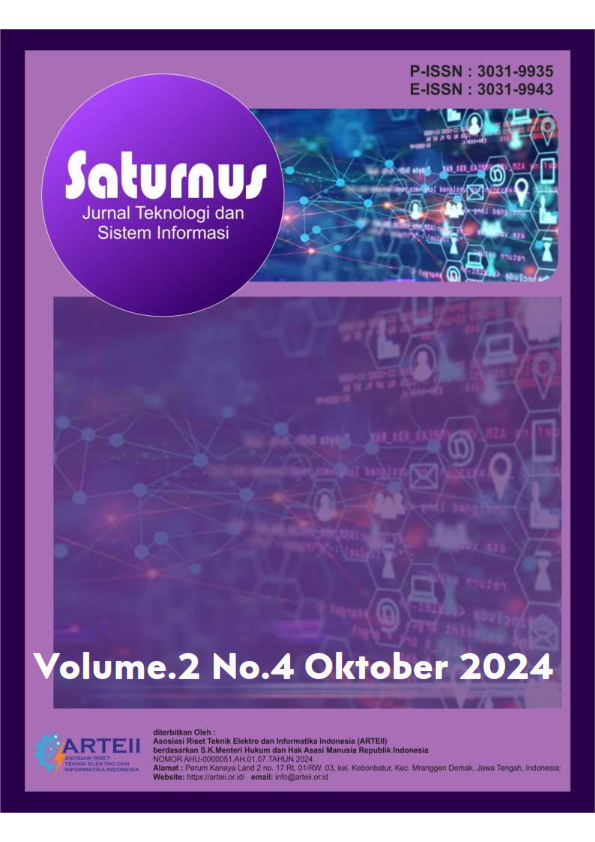Klasifikasi Tingkat Pemahaman Siswa pada Pelajaran Matematika di MTSS PAB 5 Klambir Lima
DOI:
https://doi.org/10.61132/saturnus.v2i4.345Keywords:
Mathematics, Comprehension Level Classification, Decision Tree Algorithm C4.5Abstract
According to academic data, student math ability tests at MTSS PAB 5 Klambir Lima yield mixed results. There are students who understand math well, but there are also those who have difficulty understanding the mathematical concepts themselves. Math teachers at this school have difficulty designing lessons that can meet the needs of students with different levels of understanding. So, it is necessary to group student data to produce educational decision-making and improve learning effectiveness, such as through data mining. Data mining is a semi-automated process that uses machine learning techniques, mathematics, statistics, and artificial intelligence to identify and organize information contained in large databases. The process of finding information can be done by determining the decision rule based based on the level of student understanding in mathematics lessons using the Decision Tree Algorithm C4.5 method. The use of the Decision Tree algorithm C4.5 aims to make it easier to determine decision rules based on gender, Predicate, teacher teaching methods, student learning interest, and level of understanding. Based on the results of the study, it was found that if the teacher's teaching method is good, the predicate value is B, the student's learning interest is less interested, and the gender is male, then the student's level of understanding in mathematics lessons is not understood.
References
Amallia, N., & Unaenah, E. (2018). Analisis Kesulitan Belajar Matematika Pada Siswa Kelas III Sekolah Dasar. In Nurul Amallia-Een Unaenah Attadib Journal Of Elementary Education (Vol. 3, Issue 2).
Arofah, S. N., & Marisa, F. (2018). Penerapan Data Mining untuk Mengetahui Minat Siswa pada Pelajaran Matematika menggunakan Metode K-Means Clustering. JOINTECS (Journal of Information Technology and Computer Science), 3(2). https://doi.org/10.31328/jointecs.v3i2.787
Bahri, S., & Lubis, A. (2020). Metode Klasifikasi Decision Tree Untuk Memprediksi Juara English Premier League. 2(1).
Cahyaningtyas, C., Nataliani, Y., & Widiasari, I. R. (2021). Analisis sentimen pada rating aplikasi Shopee menggunakan metode Decision Tree berbasis SMOTE. AITI: Jurnal Teknologi Informasi, 18(Agustus), 173–184.
Dwi Putra, H., Setiawan, H., Nurdianti, D., Retta, I., Desi, A., Matematika, P., & Siliwangi, I. (2018). Kemampuan Pemahaman Matematis Siswa SMP Di Bandung Barat.
Febriani, S., & Sulistiani, H. (2021). Analisis Data Hasil Diagnosa Untuk Klasifikasi Gangguan Kepribadian Menggunakan Algoritma C4.5. Jurnal Teknologi Dan Sistem Informasi (JTSI), vol.2.
Febrianti, M., Rodin, I., & Pravitasari, D. (2023). Analisis Kesulitan Belajar Siswa Kelas IV SD Windusari Belitang Jaya Pada Mata Pelajaran Matematika. Jurnal Edukasi Madrasah Ibtidaiyah, 5(1), 17–24.
Hasugian, P. S. (2018). Penerapan data Mining Untuk Klasifikasi Produk Menggunakan Algoritma K-means (studi Kasus : Toko Usaha Maju Barabai). Jurnal Mantik Penusa, 2(2), 191–198.
Hayati, U. (2024). Klasifikasi Kompetensi Siswa Di SMK Basuraga Menggunakan Algoritma decision Tree. In Jurnal Mahasiswa Teknik Informatika (Vol. 8, Issue 1). https://harzing.com/resources/publish-or-perish
Lase, D. (2024). Metode Decision Tree untuk Mahasiswa Penerima Beasiswa. https://idpress.ac.id/index.php/jip
Lestari, W., Kusmayadi, T. A., & Nurhasanah, F. (2021). Kemampuan Pemecahan Masalah matematika Ditinjau Dari Perbedaan Gender. AKSIOMA: Jurnal Program Studi Pendidikan Matematika, 10(2), 1141. https://doi.org/10.24127/ajpm.v10i2.3661
Nurdiyana, R. A., Pujiastuti, H., & Anriani, N. (2022). Analisis Kemampuan Pemahaman Matematis Siswa SMP Ditinjau Dari Minat Belajar. Jurnal Cendekia : Jurnal Pendidikan Matematika, 6(3), 2735–2748. https://doi.org/10.31004/cendekia.v6i3.1583
Rahmatul Azizah, N., Imamuddin, M., & Rahmat, T. (2022). Pemahaman Konsep Matematika Siswa Berdasarkan Jenis Kelamin. In Juring (Journal for Research in Mathematics Learning) p (Vol. 5, Issue 3).
Silviana, D., & Mardiani, D. (2021). Perbandingan Kemampuan Pemahaman Matematis Siswa melalui Mood-Understand-Recall-Digest-Expand-Review dan Discovery Learning.
Triatama, K., Puspaningrum, A. S., Sintaro, S., & Takaendengan, M. I. (2023). Rancang Bangun Sistem Informasi Nilai Akhir Siswa Berbasis Web Menggunakan Extreme Programming. Jurnal Informatika Dan Rekayasa Perangkat Lunak, 4(2), 135–140. https://doi.org/10.33365/jatika.v4i2.2581
Tune Sumar, W. (2018). Implementasi Kompetensi Guru Mengelolah Kurikulum K13 Dalam Pembelajaran Tematik Di SDN SE Kecamatan Telaga Kabupaten Gorontalo.
Yuberta, K. R., Setiawati, W., & Kurnia, L. (2019). Pengaruh Math Anxiety Terhadap Kemampuan Pemahaman Konsep Matematis Siswa Berdasarkan Gender.
Zai, C. (2022). Implementasi Data Mining Sebagai Pengolahan Data. In Portaldata.org (Vol. 2, Issue 3).
Zhila Azhari, D., Sudahri Damanik, I., & Suhendro, D. (2022). Penerapan Algoritma C4.5 Untuk Klasifikasi Tingkat Pemahaman Siswa Pada Mata Pelajaran Matematika (Vol. 1, Issue 1). https://ejurnal.pdsi.or.id/index.php/fatimah/index
Downloads
Published
How to Cite
Issue
Section
License
Copyright (c) 2024 Saturnus : Jurnal Teknologi dan Sistem Informasi

This work is licensed under a Creative Commons Attribution-ShareAlike 4.0 International License.





